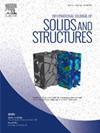通过激光粉末床熔融技术制造的 AlSi10Mg 合金的多尺度构成模型
IF 3.4
3区 工程技术
Q1 MECHANICS
International Journal of Solids and Structures
Pub Date : 2024-10-19
DOI:10.1016/j.ijsolstr.2024.113111
引用次数: 0
摘要
快速成型(AM)铝合金因其良好的性能而在各个领域得到广泛应用。数值模拟在降低实验成本和提高可靠性方面发挥着至关重要的作用。要开发可靠的结构数值模型,就必须仔细考虑 AM 铝合金固有的分层微观结构。为此,我们为通过激光粉末床融合制造的 AlSi10Mg 合金制定了一个多尺度构成模型。该模型结合了晶体塑性理论和基于微观力学的均质化方法,以建立不同长度尺度的代表性体积元素。这些尺度包括晶粒尺度、多晶尺度和宏观尺度,从而促进了它们之间的无缝过渡。该模型使用宏观和平均相应力应变关系进行校准,证明了其预测各相晶格应变的能力。此外,该模型还通过调整微观结构参数,对两相结构、熔池结构和孔隙率的影响进行了定量分析。开发的模型被嵌入到用户定义的材料子程序中,为研究 AM 合金的微观结构-性能关系提供了一种有效的方法。本文章由计算机程序翻译,如有差异,请以英文原文为准。
A multi-scale constitutive model for AlSi10Mg alloy fabricated via laser powder bed fusion
Additively Manufactured (AM) aluminum alloys find extensive applications in various fields due to their favorable properties. Numerical simulations play a crucial role in reducing experimental costs and enhancing reliability. Developing a reliable constitutive numerical model requires careful consideration of the hierarchical microstructure inherent in AM aluminum alloys. In response, a multiscale constitutive model has been formulated for the AlSi10Mg alloy, fabricated through laser powder bed fusion. This model incorporates crystal plasticity theory and micromechanics-based homogenization methods to establish representative volume elements at different length scales. These scales include the grain scale, polycrystalline scale, and macro scale, thus facilitating a seamless transition between them. The model is calibrated using macroscopic and average phase stress–strain relationships, demonstrating its capability to predict lattice strain in each phase. Additionally, this model incorporates a quantitative analysis of the effects of two-phase structure, melt pool structure, and porosity by adjusting microstructure parameters. The developed model is embedded into a user-defined material subroutine, providing an efficient approach to investigate microstructure-property relationships in AM alloys.
求助全文
通过发布文献求助,成功后即可免费获取论文全文。
去求助
来源期刊
CiteScore
6.70
自引率
8.30%
发文量
405
审稿时长
70 days
期刊介绍:
The International Journal of Solids and Structures has as its objective the publication and dissemination of original research in Mechanics of Solids and Structures as a field of Applied Science and Engineering. It fosters thus the exchange of ideas among workers in different parts of the world and also among workers who emphasize different aspects of the foundations and applications of the field.
Standing as it does at the cross-roads of Materials Science, Life Sciences, Mathematics, Physics and Engineering Design, the Mechanics of Solids and Structures is experiencing considerable growth as a result of recent technological advances. The Journal, by providing an international medium of communication, is encouraging this growth and is encompassing all aspects of the field from the more classical problems of structural analysis to mechanics of solids continually interacting with other media and including fracture, flow, wave propagation, heat transfer, thermal effects in solids, optimum design methods, model analysis, structural topology and numerical techniques. Interest extends to both inorganic and organic solids and structures.

 求助内容:
求助内容: 应助结果提醒方式:
应助结果提醒方式:


